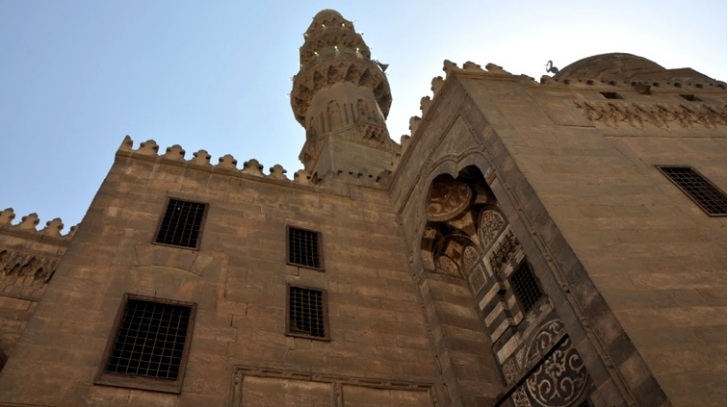A Brief Introduction to Amir Qijmas al-Ishaqi Mosque
Located in the ancient neighborhood of Darb al-Ahmar, just a stone’s throw away from Bab Zuweila and the Mosque of Sultan Al-Muayyad Shaykh, the Amir Qijmas al-Ishaqi Mosque—also known locally as Abu Hurayba Mosque—was built between 1479 and 1481 AD during Egypt's powerful Mamluk era.
It was commissioned by Amir Sayf al-Din Qijmas al-Ishaqi, a prominent figure in Sultan Qaytbay’s court, who held high-ranking positions like the commander of the pilgrimage caravan, the governor of Alexandria, and even Syria. His mosque reflects the prestige, elegance, and urban sophistication of the Mamluk elite.
Architectural Features That Will Leave You in Awe
Despite being built on a tight triangular plot of land, the Amir Qijmas al-Ishaqi Mosque Cairo is a masterpiece of spatial planning and ornamental beauty. Its architecture is a testament to the Mamluks' ability to create spiritual sanctuaries that adapt harmoniously to their urban surroundings.
What to Look For:
-
Majestic Entrance Portal
The mosque features an impressive entrance gate with alternating red and white stones (known as ablaq), topped by intricate muqarnas (stalactite-like decoration) and a row of fine Arabic calligraphy. -
Decorative Minaret and Dome
While smaller in scale compared to royal mosques, the minaret of Qijmas Mosque stands elegantly, offering beautiful geometric and stone-carved details. The dome, sitting quietly over the mihrab, adds spiritual serenity. -
Intricate Mihrab and Minbar
Inside, visitors can admire a beautifully carved mihrab (prayer niche) and a finely detailed minbar (pulpit). The craftsmanship reflects the Mamluks’ passion for religious art and sacred geometry. -
Functional Mixed-Use Design
Beneath the mosque are several small shops—an early example of using rental income to maintain religious buildings. A corridor connects the mosque to a sabil-kuttab (a public fountain and school), showcasing how Islamic architecture combined worship, education, and community service.
Why Visit Amir Qijmas al-Ishaqi Mosque?
Unlike some of Cairo’s more crowded tourist sites, Amir Qijmas al-Ishaqi Mosque Cairo offers a peaceful, reflective atmosphere where you can truly appreciate Islamic architecture at its finest.
Top Reasons to Add It to Your Itinerary:
-
Less Touristy, More Authentic: A rare gem where you’ll often be the only visitor, giving you space to absorb its quiet grandeur.
-
Near Other Landmarks: Located near Bab Zuweila and Al-Muizz Street—making it easy to include in a walking tour of Islamic Cairo.
-
Architectural Inspiration: Perfect for photography lovers, architecture students, and curious travelers seeking hidden beauty.
-
Mamluk History Up Close: Experience the craftsmanship and cultural pride of one of Cairo’s most artistic historical eras.
Tips for Travelers
-
???? Location: Darb al-Ahmar, near Bab Zuweila and Al-Muizz Street.
-
????️ Best Time to Visit: Early morning or just before sunset when the light brings out the stone details beautifully.
-
???? Dress Code: Modest clothing recommended; headscarf for women when entering.
-
???? Photography: Allowed—bring a wide-angle lens to capture the architecture.
-
????️ Combine With: Sultan Al-Muayyad Mosque, Bab Zuweila, and the historic houses along Al-Darb Al-Ahmar Street.
A Living Piece of Cairo’s Legacy
Although not as famous as the mosques of Sultan Hassan or Ibn Tulun, Amir Qijmas al-Ishaqi Mosque Cairo stands out for its elegant restraint, clever design, and quiet dignity. It serves as a beautiful reminder that Cairo’s soul is found not only in its grand monuments—but in its hidden, human-scaled corners that tell stories of devotion, ingenuity, and beauty.
So on your next visit to Cairo, skip the ordinary. Take a turn into Darb al-Ahmar and uncover the secrets of Amir Qijmas al-Ishaqi Mosque—a true architectural poem carved in stone.
Ready to explore Islamic Cairo like never before? Book your guided experience with Flying Carpet Tours and let Cairo’s hidden heritage unfold before your eyes.

